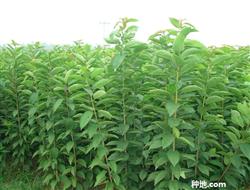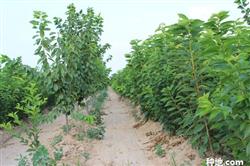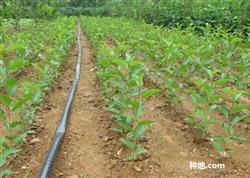How to cultivate cherry seedlings

How to cultivate big cherry seedlings? Which high-quality seedlings should be paid attention to is the basis of big cherry production. The quality of seedlings not only directly affects the speed of tree growth, the time of fruit and yield, but also has a great impact on the adaptability and stress resistance of trees. Therefore, attention should be paid to the breeding of high-quality and robust seedlings in production. The technical regulations for seedling breeding are introduced as follows. The main results are as follows: 1 there are many types of large cherry rootstocks, such as Laiyang dwarf cherry and big leaf grass cherry (also known as "Daqingye"), hairy acid, Mahari and Cote, etc. The practice shows that big-leaf grass cherry has strong adaptability to soil, is most suitable for growing in sandy loam or gravelly loam, has good resistance to root cancer, and has strong grafting affinity with big cherry varieties, deep root distribution and many thick roots. the grafted cherry has strong growth, good soil fixation, not easy to lodge and good yield. Therefore, large-leaf grass cherry should be selected as the rootstock for breeding big cherry. (2) nursery site selection and ① nursery selection. In the nursery for breeding new varieties of cherry, it is best to choose neutral loam or sandy loam with leeward and sunny, fertile soil, no continuous cropping, no waterlogging, good drainage and watering conditions. ② nursery arrangement. In the nursery, the basal fertilizer should be applied according to 5000 to 6000 grams per square meter before winter, and then deeply planed. Before raising seedlings in the next spring, ploughing and turning again, rake flat and fine, and then make beds. 3Propagation of rootstock seedlings by ⑴. A large number of root seedlings are easy to be produced around the rhizome of big-leaf cherry, which is often used as the rootstock of big cherry through ramet propagation in production. The method is as follows: in spring and summer, the root tiller seedlings growing around the root system are cultivated in soil about 30 cm thick to make them take root. After autumn or before sprouting in the next spring, the rooted tillers are separated from the plant and planted centrally or planted in the nursery for grafting big cherries. ⑵ strips were used to raise seedlings. In the production of cherry rootstocks, there are two main methods of striping propagation: vertical striping and horizontal striping. ① upright pressing strip. The big cherry rootstock seedlings were planted in the breeding nursery in autumn or early spring. When planting, first dig a ditch 30 cm deep according to the row spacing of 1.0 to 1.5 meters, and then plant the rootstock seedlings into the trench according to the plant spacing of 50 to 60 centimeters, and its root neck should be lower than the ground. The rootstock leaves 5-6 buds before germination. When the new shoots grow to about 20 cm, cultivate the soil for the first time, about 10 cm thick, and then cultivate the soil 10 cm when the new shoots grow to 40 cm. Fertilize and irrigate the soil after each cultivation. In the future, we should strengthen the comprehensive management and cultivate the soil appropriately according to the situation. after the leaves fall in autumn, we can pick the soil and split trees. ② horizontal striping. Also known as burying dry striping, it is a widely used method for rootstock propagation of big cherry at present. In early spring, the row spacing is 60cm to 70cm, the depth and width are 20cm respectively, and then the excellent one-year-old rootstock seedlings are obliquely planted in the ditch. The angle between the rootstock seedlings and the ground is about 30 degrees, and the plant spacing is roughly equal to the seedling height. After the seedlings survive, the lateral buds germinate and new shoots are produced. When the new shoots grow to about 10 cm, press the rootstocks horizontally into the bottom of the ditch, fix them with twigs, and cultivate soil about 2 cm to cover the seedlings, then water them. After that, it will grow with the new shoots and cover the soil in stages until it is level with the ground. In order to promote the growth of seedlings, 20 kg / mu of urea was applied in combination with soil cover in the first and middle of June. If the seedlings are growing well, they can be grafted in the nursery from late June to early July, and those with poor growth can be grafted in September. When the seedlings start in autumn, they are cut into independent rootstocks. (4) T-shaped bud grafting and plate bud grafting are often used in grafting seedlings. ① "T" shaped bud grafting. In Yantai big cherry producing area, the suitable time for T-shaped bud grafting can be divided into early stage and late stage. The early stage is within 15-20 days in the first and middle of June, and the later stage is from mid-July to August, sometimes lasting to mid-September for a period of about 50 days. The grafting is early (May), the scion is young, the cortex is thin, and the development of the bud is not full. After grafting too late (after mid-September), most of the branches have stopped growing, and the buds are not easy to peel off. It is the "rainy" season in the first and middle of July, and then the glue is easy to flow, and the interface is difficult to heal. Mastering the budding time is one of the keys to improve the survival rate. Scions and buds should be selected differently for grafting at different times. When budding in the early stage (early and middle June), 5-6 full buds in the middle of the robust branches should be selected as buds. During bud grafting in the later stage (July to August), the robust scion can be used as bud grafting except for basal bud and autumn shoot bud. When budding in September, full buds should be selected from the overgrown branches in the inner chamber of the crown. When grafting, cut a knife 0.5 cm above the scion bud, and then cut from 1.5 cm below the bud into the xylem to the upper cut, gently upward, and then pinch the side of the bud with your hand, that is, take off the 2 cm-sized shield bud. Then select the shaded smooth part at the base of the rootstock about 10 cm, and cut a T-shaped knife with a bud knife, reaching to the xylem. Then gently peel off the left and right cortices with the tip of the knife from top to bottom, then insert the cut buds into the incision of the rootstock, align the upper end of the buds with the transverse incisions of the rootstock, and then tie them tightly with plastic strips. ② plate budding. This method can be used all year round. The thickness of the rootstock for grafting should be more than 0.7 cm, the scion should collect 1-year-old branches, and full buds should be selected as buds. When grafting, at the base of the rootstock about 10 cm from the ground, select the smooth part, along the vertical direction, gently cut the long oval face which is about 2.5 cm and 2 mm deep. When cutting the bud, put the knife 1.5 cm below the bud, gently cut the bud piece from the scion, and cut the long oval bud piece which is 2.5 cm long and 2 mm thick. Then, stick the sprouts tightly on the cutting surface of the rootstock and tie them tightly with plastic tape. (5) manage the ① to be unbound at the right time. Check whether the grafted buds survive about half a month after grafting. If the grafted buds are fresh and dilated, it shows that they have survived. Those who did not survive should be made up in time, and the surviving buds can be untied in about 25 days, so as not to affect the germination of buds. ② cutting anvil to remove cuteness. After the grafting survived or before sprouting in spring, cut the anvil 1 cm above the grafting bud. When the rootstock buds germinate, the buds on the rootstock should be wiped out in time to promote the germination and growth of the grafted buds. In the future, it will be removed for 3 or 4 times in a row. When the new shoot grows to more than 20 cm, a pillar should be inserted next to the seedling, and the new tip should be tied and fixed to the pillar with hemp rope or plastic tape to prevent the new tip from being broken by the wind. ③ fertilizer and water management. In order to promote the growth of seedlings, attention should be paid to strengthening fertilizer and water management. Watering and topdressing in time according to drought and seedling growth. Nitrogen fertilizer is the main fertilizer in the early stage, and phosphorus and potassium fertilizer is the main fertilizer in the later stage. Should be watered after each topdressing, and often ploughed and weeded. Extra-root topdressing can be carried out for 2 or 3 times in the whole growing season. In order to improve the overwintering cold resistance of seedlings and prevent draining, it is necessary to properly control water and fertilizer in the later stage, so as to prevent seedlings from greedy and growing, resulting in unsubstantial tissue. ④ disease and pest control. During the period of seedling growth, it is necessary to do a good job in disease and pest control. After germination, it is necessary to strictly guard against the harm of the small gray weevil, which can be captured manually, or 80% crystal trichlorfon can be used as poison bait. From June to July, 1000 times of 50% fenitrothion EC or 2500 times of 2.5% deltamethrin EC can be used to control pear heart borer. From July to August, spray 65% zinc wettable powder 500 times, or 40% manganese zinc 600 times 800 times, or zinc sulfate lime solution (1 part of zinc sulfate, 4 parts of hydrated lime, 240 parts of water, fully mixed) to prevent bacterial perforation and early defoliation. Leaf roll moth, diamondback moth and other pests can be sprayed with 2000 times of Ⅲ or 1000-1500 times of dichlorvos EC. (6) the seedlings generally come out of the nursery after defoliation and before soil freezing, and the root system should be kept intact as far as possible. First, diseased seedlings and grafted seedlings were removed, and then graded according to stem height, thickness, and root development. For the local establishment of the garden, it can be directly planted. For those who are left to build the garden in the following spring, you can choose the place where the leeward does not accumulate water, dig a false planting ditch about 1 meter deep, put the seedlings oblique among them, and then cultivate the soil to the 3 places of seedling height. The seedlings shipped out of the package can be tied into a bundle every 50 to 100 trees according to the grade, and the roots are wrapped in wet straw bags to prevent the loss of water from the roots. Then tie the label on each bundle of seedlings, indicate the variety, specification and quantity, do a good job of quarantine, and then it can be delivered for export. Click to get more cherry planting techniques click to get more fruit planting techniques
- Prev

What should I pay attention to when planting big cherries?
What should we pay attention to in cherry cultivation? The cherry is warm, not cold-tolerant, drought-resistant, waterlogging-resistant and afraid of strong wind. It is suitable for cultivation in areas with an annual average temperature of 10 ℃ ~ 15 ℃. Practice has proved that when the annual average temperature is higher than 15 ℃, big cherries tend to blossom more and set less fruit. Introduce and develop big cherry.
- Next

When will the big cherry be watered?
What should we pay attention to when planting big cherry seedlings? Planting big cherry seedlings should pay attention to the following points: first, temperature big cherry is a temperature-loving but not cold-tolerant fruit tree, suitable for local cultivation with an annual average temperature of 10 to 12 degrees Celsius. Abnormal temperature refers to the high and low temperatures in the suitable temperature range of big cherries. Under normal circumstances, high.
Related
- Moge, come on! The staff of the peasant association in the producing area of cantaloupe were frightened when the crowd gathered.
- Causes and Solutions of low Fruit setting rate of Apple
- Symptoms and control measures of passion fruit virus disease
- Fruit growing lesson: how do apple orchards keep high yields?
- Can you build orchards in the mountains? What are the pros and cons?
- How to manage the coloring period of Crisson grape?
- This paper introduces the processing technology of two kinds of fig products.
- How much is a month for retired teachers in rural areas by 2020?
- How can strawberry planting increase sugar content? We should pay attention to management in many aspects.
- What are the cultivation techniques on how to improve the yield of golden fruit?

